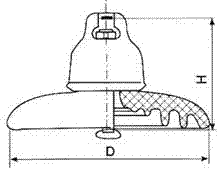Three dimensional reconstruction-based insulator creepage distance measurement system and method
A technology of creepage distance and three-dimensional reconstruction, applied in 3D modeling, details related to processing steps, image data processing, etc., can solve problems such as large measurement deviation
- Summary
- Abstract
- Description
- Claims
- Application Information
AI Technical Summary
Problems solved by technology
Method used
Image
Examples
Embodiment 1
[0048] see Figure 2 ~ Figure 4 , the insulator creepage distance measurement system based on three-dimensional reconstruction, including a horizontal electric turntable (1), a depth sensor Kinect v2 (2), and an ASUS notebook computer (3), is characterized in that: the insulator to be tested faces downward according to the umbrella handle Put the umbrella skirt upwards on the horizontal electric turntable (1) rotating at a constant speed, and place a depth sensor Kinect v2 (2) on the support at a distance of 0.4-4m from the horizontal electric turntable to scan the insulator (4) 360°. Obtain the depth image and color image of the insulator, connect the output of Kinect v2 (2) to the laptop (3), use the KinectFusion algorithm in the laptop (3) to perform 3D reconstruction based on voxel data, and then rely on the voxel grid Data type, select the appropriate cutting surface for cutting, intercept the correct two-dimensional section, and traverse according to the effective contou...
Embodiment 2
[0050] This method for measuring the creepage distance of insulators based on three-dimensional reconstruction uses the above-mentioned system for operation, and is characterized in that the specific operation steps are as follows:
[0051] ① Depth image acquisition: use Kinect v2 (2) to scan the insulator (4) 360°, and collect its depth image;
[0052] ② Reconstruction of 3D model: the collected images are fused into a complete 3D model with voxel grid form through the KinectFusion algorithm;
[0053] ③Find the cutting surface: The key to cutting the voxel grid is to find the correct cutting surface. Due to the complexity of the structure of the insulator (4), it cannot be cut simply and directly. It needs to be cut into 2D section;
[0054] ④ Mesh voxel cutting: Aiming at the structure of the insulator itself, cut along the plane passing through the diameter of the shed of the insulator in the obtained 3D model, divide the insulator into two symmetrical parts, and obtain a ...
Embodiment 3
[0057] This embodiment is basically the same as Embodiment 2, and the special features are as follows:
[0058] 1. the described insulator creepage distance measurement method based on three-dimensional reconstruction, use the KinectFusion algorithm framework to carry out three-dimensional reconstruction in step (2) and obtain the voxel grid with directed distance function;
[0059] 2. In the method for measuring creepage distance of insulators based on three-dimensional reconstruction, before using the KinectFusion algorithm in step (2), first use OPENNI SDK2 to automatically align the coordinate system of the depth camera and the color camera, and take the coordinate system of the depth camera as the global coordinate system to create a voxel grid.
[0060] 3. The insulator creepage distance measurement method based on three-dimensional reconstruction, in step (2), in order to cut the model voxel grid in the follow-up, the image of the insulator (4) facing the depth camera c...
PUM
 Login to View More
Login to View More Abstract
Description
Claims
Application Information
 Login to View More
Login to View More - R&D
- Intellectual Property
- Life Sciences
- Materials
- Tech Scout
- Unparalleled Data Quality
- Higher Quality Content
- 60% Fewer Hallucinations
Browse by: Latest US Patents, China's latest patents, Technical Efficacy Thesaurus, Application Domain, Technology Topic, Popular Technical Reports.
© 2025 PatSnap. All rights reserved.Legal|Privacy policy|Modern Slavery Act Transparency Statement|Sitemap|About US| Contact US: help@patsnap.com



